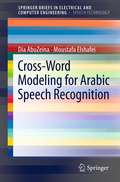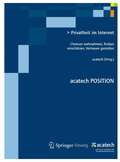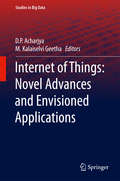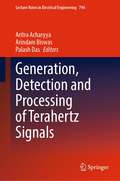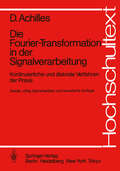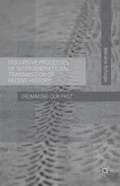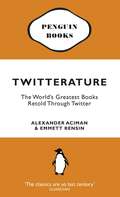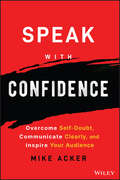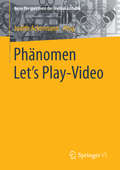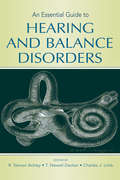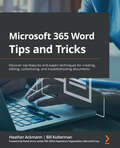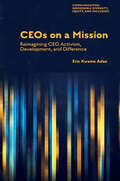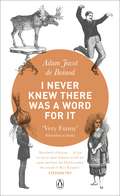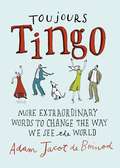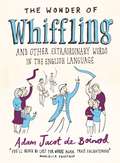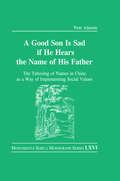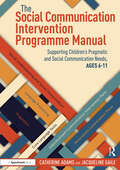- Table View
- List View
Cross-Word Modeling for Arabic Speech Recognition (SpringerBriefs in Speech Technology)
by Dia AbuZeina Moustafa ElshafeiCross-Word Modeling for Arabic Speech Recognition utilizes phonological rules in order to model the cross-word problem, a merging of adjacent words in speech caused by continuous speech, to enhance the performance of continuous speech recognition systems. The author aims to provide an understanding of the cross-word problem and how it can be avoided, specifically focusing on Arabic phonology using an HHM-based classifier.
James Acaster's Guide to Quitting Social Media
by James AcasterThis is a self-help book like no other. Because you are not helping yourself, James Acaster is helping you.In 2019, James quit all forms of social media - covering his phone in tar and driving it to a lock-up in Rhyl, before setting up home in a castle he'd built himself called Castle Anti-Net. But when the withdrawal symptoms hit him, he realised in order to stay clean he'd have to replace everything social media gave him with three-dimensional, real-life activities. Employing the help of a mysterious, wealthy benefactor named Clancy Dellahue, and an ever-growing gang of misfits (aka the Tangfastic Crew), James found ways to replace his online friends (he joined the scouts) and spy on his exes (climbing ropes, zip lines, fake moustache) as well as anonymously bullying strangers, seeing photos of everyone's dogs, getting public figures fired, arguing with everybody about everything, and so much more. His life is amazing and yours could be too if you buy JAMES ACASTER'S GUIDE TO QUITTING SOCIAL MEDIA, BEING THE BEST YOU YOU CAN BE AND SAVING YOURSELF FROM LONELINESS VOL. 1.
Privatheit im Internet: Chancen wahrnehmen, Risiken einschätzen, Vertrauen gestalten (acatech POSITION)
by AcatechMit seinen digitalen Marktplätzen, Suchmaschinen, sozialen Netzwerken und vielen anderen Diensten kann das Internet zur Verwirklichung grundlegender europäischer Werte beitragen: freie Selbstbestimmung, politische Partizipation und wirtschaftliches Wohlergehen der Menschen. Allerdings bezahlen Nutzerinnen und Nutzer Internet-Dienste häufig mit Daten statt mit Geld, wodurch ihre Privatheit infrage gestellt wird. Angesichts dieser Spannung zeigt acatech, wie eine Internet-Kultur entwickelt werden kann, die es erlaubt, die Chancen des Internets wahrzunehmen und dabei die Privatheit der Menschen schützt. Diese achatech Position enthält konkrete Handlungsempfehlungen, wie Bildung, Wirtschaft, Recht und Technik zu einer solchen Kultur beitragen können.
Internet of Things: Novel Advances and Envisioned Applications (Studies in Big Data #25)
by D. P. Acharjya M. Kalaiselvi GeethaThis book focuses on a combination of theoretical advances in the Internet of Things, cloud computing and its real-life applications to serve society. The book discusses technological innovations, authentication, mobility support and security, group rekeying schemes and a range of concrete applications. The Internet has restructured not only global interrelations, but also an unbelievable number of personal characteristics. Machines are increasingly able to control innumerable autonomous gadgets via the Internet, creating the Internet of Things, which facilitates intelligent communication between humans and things, and among things. The Internet of Things is an active area of current research, and technological advances have been supported by real-life applications to establish their soundness. The material in this book includes concepts, figures, graphs, and tables to guide researchers through the Internet of Things and its applications for society.
Generation, Detection and Processing of Terahertz Signals (Lecture Notes in Electrical Engineering #794)
by Aritra Acharyya Arindam Biswas Palash DasThis book contains detailed descriptions and associated discussions regarding different generation, detection and signal processing techniques for the electrical and optical signals within the THz frequency spectrum (0.3–10 THz). It includes detailed reviews of some recently developed electronic and photonic devices for generating and detecting THz waves, potential materials for implementing THz passive circuits, some newly developed systems and methods associated with THz wireless communication, THz antennas and some cutting-edge techniques associated with the THz signal and image processing. The book especially focuses on the recent advancements and several research issues related to THz sources, detectors and THz signal and image processing techniques; it also discusses theoretical, experimental, established and validated empirical works on these topics. The book caters to a very wide range of readers from basic science to technological experts as well as students.
Early Modern English Marginalia (Material Readings in Early Modern Culture)
by Katherine AchesonMarginalia in early modern and medieval texts – printed, handwrit- ten, drawn, scratched, colored, and pasted in – offer a glimpse of how people, as individuals and in groups, interacted with books and manu- scripts over often lengthy periods of time. The chapters in this volume build on earlier scholarship that established marginalia as an intellec- tual method (Grafton and Jardine), as records of reading motivated by cultural, social, theological, and personal inclinations (Brayman [Hackel] and Orgel), and as practices inspired by material affordances particular to the book and the pen (Fleming and Sherman). They further the study of the practices of marginalia as a mode – a set of ways in which material opportunities and practices overlap with intellectual, social, and personal motivations to make meaning in the world. They introduce us to a set of idiosyncratic examples such as the trace marks of objects left in books, deliberately or by accident; cut-and-pasted additions to printed volumes; a marriage depicted through shared book ownership. They reveal to us in case studies the unique value of mar- ginalia as evidence of phenomena as important and diverse as religious change, authorial self-invention, and the history of the literary canon. The chapters of this book go beyond the case study, however, and raise broad historical, cultural, and theoretical questions about the strange, marvelous, metamorphic thing we call the book, and the equally mul- tiplicitous, eccentric, and inscrutable beings who accompany them through history: readers and writers.
Early Modern English Marginalia (Material Readings in Early Modern Culture)
by Katherine AchesonMarginalia in early modern and medieval texts – printed, handwrit- ten, drawn, scratched, colored, and pasted in – offer a glimpse of how people, as individuals and in groups, interacted with books and manu- scripts over often lengthy periods of time. The chapters in this volume build on earlier scholarship that established marginalia as an intellec- tual method (Grafton and Jardine), as records of reading motivated by cultural, social, theological, and personal inclinations (Brayman [Hackel] and Orgel), and as practices inspired by material affordances particular to the book and the pen (Fleming and Sherman). They further the study of the practices of marginalia as a mode – a set of ways in which material opportunities and practices overlap with intellectual, social, and personal motivations to make meaning in the world. They introduce us to a set of idiosyncratic examples such as the trace marks of objects left in books, deliberately or by accident; cut-and-pasted additions to printed volumes; a marriage depicted through shared book ownership. They reveal to us in case studies the unique value of mar- ginalia as evidence of phenomena as important and diverse as religious change, authorial self-invention, and the history of the literary canon. The chapters of this book go beyond the case study, however, and raise broad historical, cultural, and theoretical questions about the strange, marvelous, metamorphic thing we call the book, and the equally mul- tiplicitous, eccentric, and inscrutable beings who accompany them through history: readers and writers.
Die Fourier-Transformation in der Signalverarbeitung: Kontinuierliche und diskrete Verfahren der Praxis (Hochschultext)
by Dietmar AchillesDiscursive Processes of Intergenerational Transmission of Recent History: (Re)making Our Past
by M. AchugarDebates about how to remember politically contested or painful pasts exist throughout the world. As with the case of the Holocaust in Europe and Apartheid in South Africa, South American countries are struggling with the legacy of state terrorism left by the 1970s dictatorships. Coming to terms with the past entails understanding the role different social actors played in those events as well as what those event mean for us today. Young people in these situations have to learn about painful historical events over which there is no national consensus. This book explores discursive processes of intergenerational transmission of recent history through the case of the Uruguayan dictatorship. The main themes of the book are the discursive construction of social memory and intergenerational transmission of contested pasts through recontextualization, resemiotization and intertextuality.
Twitterature: The World's Greatest Books Retold Through Twitter
by Alexander Aciman Emmett RensinFrom Oedipus: PARTY IN THEBES!!! Nobody cares I killed that old dude, plus this woman is all over me. Total MILF.From Paradise Lost: OH MY GOD I'M IN HELL.Perhaps you once asked yourself, 'What exactly is Hamlet trying to tell me? Why must he mince his words, muse in lyricism and, in short, whack about the shrub?' No doubt such questions would have been swiftly resolved were the Prince of Denmark a registered user on Twitter.com. This, in essence, is Twitterature.From Hamlet: WTF IS POLONIUS DOING BEHIND THE CURTAIN??? Here are over 60 of the greatest works of literature - from Beowulf to Bronte, Kafka to Kerouac, Dostoevsky to Dickens - distilled in the voice of Twitter to their pithiest essence, providing everything you need to master the literature of the civilised world, while relieving you of the task of reading it.From Dante's Inferno: I'm havin a midlife crisis. Lost in the woods. Shoulda brought my iPhone.
Speak with Confidence: Overcome Self-Doubt, Communicate Clearly, and Inspire Your Audience
by Mike AckerBuild your communication confidence and master the ability to inspire your audience In Speak with Confidence: Overcome Self-Doubt, Communicate Clearly, and Inspire Your Audience, keynote speaker, author, and executive communication coach Mike Acker delivers a practical and hands-on playbook to building the confidence you need to nail your next presentation, speech, virtual talk, or social media post. In this proven pathway to becoming a capable and confident speaker, you’ll discover how to combine your identity, message, and skills into one persuasive package. The author explains how to uncover your identity, define your message, and develop your skills and techniques to become a master communicator. From overcoming imposter syndrome to eliminating a victim mentality, you’ll explore concrete methods for improving your presence and ability to take command of a room. You’ll also find: The elements of a confident message, including a personal investment in the topic you’re discussing Strategies for overcoming limiting beliefs that hold you back and artificially reduce your ability to lead Ways to understand your audience and learn to hone in on the place where your purpose intersects with your audience’s needsAn essential new strategy guide for anyone seeking to improve their ability to speak to a group, Speak with Confidence is the public speaking blueprint you’ve been waiting for.
Speak with Confidence: Overcome Self-Doubt, Communicate Clearly, and Inspire Your Audience
by Mike AckerBuild your communication confidence and master the ability to inspire your audience In Speak with Confidence: Overcome Self-Doubt, Communicate Clearly, and Inspire Your Audience, keynote speaker, author, and executive communication coach Mike Acker delivers a practical and hands-on playbook to building the confidence you need to nail your next presentation, speech, virtual talk, or social media post. In this proven pathway to becoming a capable and confident speaker, you’ll discover how to combine your identity, message, and skills into one persuasive package. The author explains how to uncover your identity, define your message, and develop your skills and techniques to become a master communicator. From overcoming imposter syndrome to eliminating a victim mentality, you’ll explore concrete methods for improving your presence and ability to take command of a room. You’ll also find: The elements of a confident message, including a personal investment in the topic you’re discussing Strategies for overcoming limiting beliefs that hold you back and artificially reduce your ability to lead Ways to understand your audience and learn to hone in on the place where your purpose intersects with your audience’s needsAn essential new strategy guide for anyone seeking to improve their ability to speak to a group, Speak with Confidence is the public speaking blueprint you’ve been waiting for.
Phänomen Let´s Play-Video: Entstehung, Ästhetik, Aneignung und Faszination aufgezeichneten Computerspielhandelns (Neue Perspektiven der Medienästhetik)
by Judith AckermannTrotz ihrer Relevanz und Verbreitung haben Let’s Play-Videos bislang kaum Einzug in die (medien-)wissenschaftliche Forschung gehalten. Dieser Sammelband hinterfragt das junge Phänomen nicht nur aus medientheoretischer und medienästhetischer Sicht, sondern hinterfragt zugleich die mit ihm einhergehenden performativen Qualitäten. Zusätzlich werden produktionsbezogene und aneignungsorientierte Perspektiven auf das Forschungsfeld präsentiert. Die Ausführungen werden durch einen Anwendungsteil ergänzt, der den Stellenwert von Let’s Play-Videos in der Medienpädagogik diskutiert und praxisnahe Einsatzszenarien für unterschiedliche Bildungskontexte vorstellt.
An Essential Guide to Hearing and Balance Disorders
by R. Steven Ackley T. Newell Decker Charles J. LimbAn Essential Guide to Hearing and Balance Disorders consolidates the most significant clinical aspects of hearing and balance disorders, ranging from cause and diagnosis to treatment and cure. Experts in various subspecialties of this extensive topic introduce readers to the most sophisticated and state of the art methods of diagnosis and treatment. Each chapter expands on a specific topic area along the continuum of how medical personnel diagnose hearing and balance disorders, to how surgical implantation of the cochlea and rehabilitation can remedy various conditions. In concise format, the book begins with a case history and follows with comprehensive descriptions of current knowledge regarding fundamental causes of hearing loss and balance disorders, as well as a thorough examination of objective assessment. The latter half of the volume presents specialized treatment and rehabilitative options for various disorders. The chapters in this part cover special topics and conclude with pertinent case studies. Unique areas of discussion in a text of this kind include: genetics of deafness pediatric hearing loss and hearing loss later in life business essentials in audiology private practice professional issues, such as ethics, methods of practice, and conflicts of interest. As its title implies, this book is critically important for all students and professionals in hearing/balance related disciplines, including audiology, otolaryngology, general medicine, and rehabilitation oriented allied health care occupations.
An Essential Guide to Hearing and Balance Disorders
by R. Steven Ackley T. Newell Decker Charles J. LimbAn Essential Guide to Hearing and Balance Disorders consolidates the most significant clinical aspects of hearing and balance disorders, ranging from cause and diagnosis to treatment and cure. Experts in various subspecialties of this extensive topic introduce readers to the most sophisticated and state of the art methods of diagnosis and treatment. Each chapter expands on a specific topic area along the continuum of how medical personnel diagnose hearing and balance disorders, to how surgical implantation of the cochlea and rehabilitation can remedy various conditions. In concise format, the book begins with a case history and follows with comprehensive descriptions of current knowledge regarding fundamental causes of hearing loss and balance disorders, as well as a thorough examination of objective assessment. The latter half of the volume presents specialized treatment and rehabilitative options for various disorders. The chapters in this part cover special topics and conclude with pertinent case studies. Unique areas of discussion in a text of this kind include: genetics of deafness pediatric hearing loss and hearing loss later in life business essentials in audiology private practice professional issues, such as ethics, methods of practice, and conflicts of interest. As its title implies, this book is critically important for all students and professionals in hearing/balance related disciplines, including audiology, otolaryngology, general medicine, and rehabilitation oriented allied health care occupations.
Microsoft 365 Word Tips And Tricks: Discover Top Features And Expert Techniques For Creating, Editing, Customizing, And Troubleshooting Documents
by Heather Ackmann Bill KultermanDiscover top features and expert techniques for creating, editing, customizing, and troubleshooting documents
CEOs on a Mission: Reimagining CEO Activism, Development, and Difference (Communicating Responsible Diversity, Equity, and Inclusion)
by Eric Kwame AdaeToday, CEOs function increasingly as social activists, often pursuing socio-political causes which fall outside of their usual pursuit of the corporate or financial bottom line. Based on a series of long interviews and the application of alternative theoretical lenses, this book examines this phenomenon within the African context on the road to creating a CEO Activism Development Model. Addressing the gender disparity that continues to persist in this field, chapters consider alternative perspectives on corporate socio-political involvement, including motivations, tactics, safeguards and guidelines. Through a distinct postmodern lens, Eric Kwame Adae further explores how CEO activism fits into more specific African contexts and intersects with certain Afrocentric philosophies, including Caritas, Ubuntu philosophy and Africapitalism. Breaking new ground in his analysis of CEO activism within a non-Western sociocultural context, Eric Kwame Adae presents an exciting exploration of the theoretical, managerial, practical and methodological implications of CEO activism today.
CEOs on a Mission: Reimagining CEO Activism, Development, and Difference (Communicating Responsible Diversity, Equity, and Inclusion)
by Eric Kwame AdaeToday, CEOs function increasingly as social activists, often pursuing socio-political causes which fall outside of their usual pursuit of the corporate or financial bottom line. Based on a series of long interviews and the application of alternative theoretical lenses, this book examines this phenomenon within the African context on the road to creating a CEO Activism Development Model. Addressing the gender disparity that continues to persist in this field, chapters consider alternative perspectives on corporate socio-political involvement, including motivations, tactics, safeguards and guidelines. Through a distinct postmodern lens, Eric Kwame Adae further explores how CEO activism fits into more specific African contexts and intersects with certain Afrocentric philosophies, including Caritas, Ubuntu philosophy and Africapitalism. Breaking new ground in his analysis of CEO activism within a non-Western sociocultural context, Eric Kwame Adae presents an exciting exploration of the theoretical, managerial, practical and methodological implications of CEO activism today.
I Never Knew There Was a Word For It
by Adam Jacot de BoinodFrom 'shotclog', a Yorkshire term for a companion only tolerated because he is paying for the drinks, to Albanian having 29 words to describe different kinds of eyebrows, the languages of the world are full of amazing, amusing and illuminating words and expressions that will improve absolutely everybody's quality of life. All they need is this book! This bumper volume gathers all three of Adam Jacot de Boinod's acclaimed books about language - The Wonder of Whiffling, The Meaning of Tingo and Toujours Tingo (their fans include everyone from Stephen Fry to Michael Palin) - into one highly entertaining, keenly priced compendium. As Mariella Frostup said 'You'll never be lost for words again!'
Toujours Tingo: Extraordinary Words to Change the Way We See the World
by Adam Jacot de BoinodWhy would Germans accuse you of being like the donkey getting cross with a rabbit? Who would a Spaniard tell to go and fry asparagus? And when might the French claim they are without a radish? Furthering your knowledge of the world’s unusual idioms, Toujours Tingo will also explain how ordering ‘lamb’ in Ethiopia may see a cow delivered to your table, and how politicians in Sweden may be encouraged occasionally to göra en hel Pudel (‘do a full poodle’) with some humble apologising. Covering such wide-ranging linguistic necessities as arguing, raising children, working and dining out, and filling all those gaps that English leaves thoughtlessly unplugged, this book’s charm would – for Russians at least – be ežiku ponjatno (obvious even to a hedgehog).
The Wonder of Whiffling: (and other extraordinary words in the English language)
by Adam Jacot de BoinodThe Wonder of Whiffling is a hugely enjoyable, surprising and rewarding tour of English around the globe (with fine coinages from our English-speaking cousins across the pond, Down Under and elsewhere).Discover all sorts of words you've always wished existed but never knew, such as fornale, to spend one's money before it has been earned; cagg, a solemn vow or resolution not to get drunk for a certain time; and petrichor, the pleasant smell that accompanies the first rain after a dry spell. Delving passionately into the English language, Adam Jacot de Boinod also discovers why it is you wouldn't want to have dinner with a vice admiral of the narrow seas, why Jacobites toasted the little gentleman in black velvet, and why a Nottingham Goodnight is better than one from anywhere else.
Good Son is Sad If He Hears the Name of His Father: The Tabooing of Names in China as a Way of Implementing Social Values
by Piotr AdamekWhen in 1775 the scholar Wang Xihou compiled a dictionary called Ziguan , he wrote, for illustrative purposes, the personal names of Confucius and the three emperors Kangxi, Yongzheng and Qianlong in the introduction. In oversight, he recorded their complete names. This accidental writing of a few names was condemned by Emperor Qianlong as an unprecedented crime, rebellion and high treason. Wang Xihou was executed, his property confiscated and his books were burnt. His family was arrested and his sons and grandsons were killed or sent as slaves to Heilongjiang. It is surprising what an enormous impact the tabooing of names (bihui ) had on Chinese culture. The names of sovereigns, ancestors, officials, teachers, and even friends were all considered taboo, in other words it was prohibited to pronounce them or to record them in writing. In numerous cases characters identical or similar in writing or pronunciation were often avoided as well. The tabooing of names was observed in the family and on the street, in the office and in the emperor's palace. The practice of bihui had serious consequences for the daily lives of the Chinese and for Chinese historiography. People even avoided certain places and things, and refused to accept offices. They were punished and sometimes even killed in connection with the tabooing of names. The bihui custom existed as an important element of Chinese culture and was perceived as significant by Chinese and foreigners alike. It was crucial for implementing social values and demonstrating the political hierarchy. The present work A Good Son Is Sad if He Hears the Name of His Father is a systematic study of Chinese name-tabooing customs, which until now have been relatively little explored in Western-language Sinological studies. It attempts to provide a long-term perspective on the changing dynamics of tabooing and elucidates various aspects related to the fascinating topic of tabooing of names.
Good Son is Sad If He Hears the Name of His Father: The Tabooing of Names in China as a Way of Implementing Social Values (Monumenta Serica Monograph Ser.)
by Piotr AdamekWhen in 1775 the scholar Wang Xihou compiled a dictionary called Ziguan , he wrote, for illustrative purposes, the personal names of Confucius and the three emperors Kangxi, Yongzheng and Qianlong in the introduction. In oversight, he recorded their complete names. This accidental writing of a few names was condemned by Emperor Qianlong as an unprecedented crime, rebellion and high treason. Wang Xihou was executed, his property confiscated and his books were burnt. His family was arrested and his sons and grandsons were killed or sent as slaves to Heilongjiang. It is surprising what an enormous impact the tabooing of names (bihui ) had on Chinese culture. The names of sovereigns, ancestors, officials, teachers, and even friends were all considered taboo, in other words it was prohibited to pronounce them or to record them in writing. In numerous cases characters identical or similar in writing or pronunciation were often avoided as well. The tabooing of names was observed in the family and on the street, in the office and in the emperor's palace. The practice of bihui had serious consequences for the daily lives of the Chinese and for Chinese historiography. People even avoided certain places and things, and refused to accept offices. They were punished and sometimes even killed in connection with the tabooing of names. The bihui custom existed as an important element of Chinese culture and was perceived as significant by Chinese and foreigners alike. It was crucial for implementing social values and demonstrating the political hierarchy. The present work A Good Son Is Sad if He Hears the Name of His Father is a systematic study of Chinese name-tabooing customs, which until now have been relatively little explored in Western-language Sinological studies. It attempts to provide a long-term perspective on the changing dynamics of tabooing and elucidates various aspects related to the fascinating topic of tabooing of names.
The Social Communication Intervention Programme Manual: Supporting Children's Pragmatic and Social Communication Needs, Ages 6-11 (The Social Communication Intervention Programme)
by Catherine Adams Jacqueline GaileThe Social Communication Intervention Programme (SCIP) has been developed to support school-aged children (6–11 years) with social communication, pragmatic, and language needs. The Social Communication Intervention Programme Manual provides a rationale and method for providing specialist level language therapy for these children who have significant social communication differences. Evidence for the effectiveness of SCIP is included in The Manual.This book introduces the SCIP model and explores the three main components: social understanding/social inference, pragmatics, and language processing. Guidance is included on how to link assessment with therapy, how to plan and individualise interventions, and how to proceed with the programme. It contains a wealth of real-life case examples to illustrate key points, with step-by-step instructions for carrying out the interventions.Used alongside The Social Communication Intervention Programme Resource, this book offers a truly practical, tried-and-tested model to provide targeted, individualised intervention for children with social communication challenges. It is an essential tool for speech and language therapists, specialist teachers, and psychologists who are working with children with social communication, pragmatic, and language needs.For the most effective use, The SCIP Manual should be purchased alongside The SCIP Resource.
The Social Communication Intervention Programme Manual: Supporting Children's Pragmatic and Social Communication Needs, Ages 6-11 (The Social Communication Intervention Programme)
by Catherine Adams Jacqueline GaileThe Social Communication Intervention Programme (SCIP) has been developed to support school-aged children (6–11 years) with social communication, pragmatic, and language needs. The Social Communication Intervention Programme Manual provides a rationale and method for providing specialist level language therapy for these children who have significant social communication differences. Evidence for the effectiveness of SCIP is included in The Manual.This book introduces the SCIP model and explores the three main components: social understanding/social inference, pragmatics, and language processing. Guidance is included on how to link assessment with therapy, how to plan and individualise interventions, and how to proceed with the programme. It contains a wealth of real-life case examples to illustrate key points, with step-by-step instructions for carrying out the interventions.Used alongside The Social Communication Intervention Programme Resource, this book offers a truly practical, tried-and-tested model to provide targeted, individualised intervention for children with social communication challenges. It is an essential tool for speech and language therapists, specialist teachers, and psychologists who are working with children with social communication, pragmatic, and language needs.For the most effective use, The SCIP Manual should be purchased alongside The SCIP Resource.
